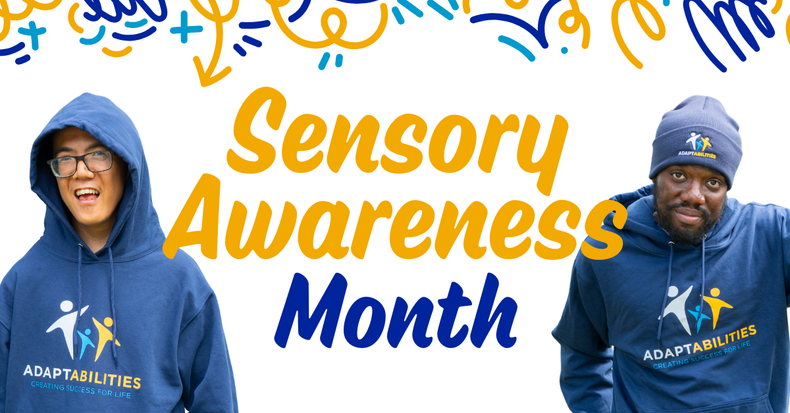October is Sensory Awareness Month, a time to shine light on the millions of children and adults who experience the world differently through their senses. Some people feel overwhelmed by everyday sounds, textures, or movements. Others seek more sensory input to feel alert and organized. Understanding these differences and knowing how to support them can transform daily life for families, students, and communities.
Below is a clear look at what sensory processing means, how to recognize sensory differences, and practical ways sensory tools can help create more inclusive spaces at home, school, and beyond.
What is Sensory Processing?
Sensory processing is how our nervous system receives, organizes, and responds to sensory information from our environment and our own bodies. This includes the familiar five senses — sight, sound, smell, taste, and touch — plus two critical systems many people haven't heard of: vestibular (balance and spatial orientation) and proprioceptive (body position and movement).
When sensory processing works smoothly, we can filter important information from background noise, stay calm in busy environments, and move through daily routines with ease. When it doesn't work as expected, ordinary experiences can feel overwhelming, under-stimulating, or confusing.
AHS reports that sensory processing differences affect an estimated 1 in 6 people. These differences often co-occur with autism, ADHD, anxiety, and learning disabilities, but they can also appear on their own.

Recognizing Sensory Processing Differences
Sensory processing differences show up in many ways across all ages. Some people are sensory seeking, craving movement, deep pressure, or intense sensory experiences to feel organized and alert. Others are sensory avoiding, feeling overwhelmed by sensory input and working to minimize exposure to certain textures, sounds, or movements.
Many people experience a mix of both patterns across different sensory systems.
Common signs of sensory seeking behaviors:
-
Constantly moving, fidgeting, or needing to pace
-
Seeking tight hugs, heavy pressure, or firm touch
-
Touching surfaces, objects, or fidgeting with items
-
Preferring loud music or making vocal sounds
-
Chewing on objects, clothing, or seeking crunchy foods
Common signs of sensory avoiding behaviors:
-
Covering ears or avoiding noisy environments
-
Refusing certain clothing textures or fabric types
-
Avoiding crowded spaces or physical contact
-
Getting overwhelmed in busy or unpredictable environments
-
Having strong negative reactions to unexpected sensations
Other signs that may indicate sensory processing differences:
-
Difficulty with focus and attention in certain environments
-
Trouble with transitions between activities or locations
-
Emotional overwhelm or shutdowns in sensory-rich spaces
-
Coordination challenges or appearing unaware of body position
-
Extreme reactions to everyday sensory experiences
These behaviors aren't defiance or attention-seeking. They're the nervous system's attempt to manage sensory information that feels too intense, insufficient, or poorly organized.

How Sensory Processing Affects Daily Life
Sensory processing differences can impact every part of daily life, from morning routines and work tasks to social interactions and community participation.
At home: Morning routines might be challenging if clothing textures feel uncomfortable or household sounds seem overwhelming. Mealtimes can become stressful if food textures or dining room lighting trigger strong reactions. Evening wind-down may be difficult for people who crave movement or feel alert in quiet environments.
At work or school: Office environments with fluorescent lights, background conversations, and crowded spaces can overwhelm some people while leaving others feeling under-stimulated. Focus and productivity become harder when the nervous system is working overtime to process sensory information.
In the community: Grocery stores, restaurants, public transportation, and other community spaces can feel chaotic and unpredictable for people with sensory processing differences. This can limit participation in social activities, errands, and community engagement.
The good news is that with understanding and appropriate supports, people with sensory processing differences can participate fully in all aspects of life.
How Sensory Tools Support Daily Functioning
Sensory tools provide controlled sensory input that can help people feel more organized, calm, and ready to participate in daily activities. These tools work by giving the nervous system the specific type and amount of sensory information it needs to function optimally.
Deep pressure tools like weighted blankets, lap pads, and compression clothing provide calming, organizing input through the proprioceptive system. Research shows that deep pressure can reduce anxiety, improve focus, and support better sleep for people across age groups.
Movement tools like wobble cushions, balance boards, and sensory swings provide vestibular and proprioceptive input that can help with attention, regulation, and body awareness. Movement is especially important for people who are sensory seeking.
Tactile tools like fidget items, textured surfaces, and sensory materials provide controlled touch experiences that can be calming or alerting depending on individual needs.
Environmental modifications like noise-reducing headphones, lighting adjustments, and visual organization systems help manage sensory input in everyday environments.
The key is finding the right combination of tools and strategies for each person's unique sensory profile and daily routines.
Building Sensory-Friendly Environments
Creating sensory-friendly spaces doesn't require expensive equipment or major renovations. Small changes can make a big difference in how comfortable and successful people feel in different environments.
At home:
-
Create a calm space with adjustable lighting and comfortable seating
-
Offer choices in clothing textures and food presentations
-
Establish predictable routines that include sensory regulation activities
-
Keep sensory tools accessible for self-regulation throughout the day
At work or school:
-
Provide flexible seating options like wobble cushions or standing desks
-
Use visual schedules and clear communication about transitions
-
Offer sensory breaks with movement or calming activities
-
Train staff and colleagues to recognize and respond to sensory needs
In the community:
-
Choose off-peak times for errands and outings when possible
-
Bring familiar sensory tools like headphones or fidget items
-
Practice new environments during less busy times
-
Have a plan for managing sensory overload or under-stimulation
Our Sensory Support Tools
AdaptStore carries research-backed sensory tools designed to support regulation, focus, and participation across environments. Each tool provides specific types of sensory input that can help people feel more organized and ready to engage with their world.
Weighted Sensory Products
Weighted Stuffed Animals provide deep pressure input through a comforting format suitable for all ages. The gentle weight can help reduce anxiety and improve focus during reading, homework, work tasks, or transition times. Available in multiple weights to accommodate different ages and preferences.
Weighted Neck Pillows offer calming pressure across the shoulders and upper back, supporting both emotional regulation and postural awareness. Particularly helpful for students and office workers who need organizing input during desk work or focused activities.
Weighted Lap Pads provide steady deep pressure across the legs without the bulk of a full weighted blanket. Easy to use in classrooms, during car rides, at homework time, or while working from home.
Movement and Positioning Tools
Wobble Cushions allow for subtle movement while sitting, helping students and adults who need vestibular input to maintain attention. The unstable surface engages core muscles and provides ongoing proprioceptive feedback.
Cotton Sensory Swings create a cozy environment for calming vestibular input and gentle compression. The rhythmic swinging motion combined with the fabric's embrace can help with regulation and emotional processing.
Tactile and Fidget Tools
Polyhedron Stress Ball provides tactile stimulation and stress relief through its unique geometric surface texture. The varied surfaces offer different sensory experiences in one compact tool, perfect for desk work or meeting situations.
Hand Exerciser combines tactile input with strengthening benefits, making it ideal for people who need both sensory stimulation and fine motor skill development. Particularly useful for adults in workplace settings.
Chewy Necklace offers discrete oral sensory input for people who seek oral stimulation or have oral motor needs. Designed to be safe, durable, and socially appropriate across age groups and environments.
All of these tools work best when they're part of a broader understanding of individual sensory needs and consistent routines that support regulation throughout the day.
Looking Forward: Creating Inclusive Communities
As we observe Sensory Awareness Month, the goal isn't just awareness — it's action. Creating truly inclusive communities means recognizing that people experience the world differently and ensuring that everyone has the supports they need to participate fully.
This includes making sensory tools and accommodations available, training professionals to recognize and support sensory needs, and building environments that work for everyone's nervous systems.
Every purchase at AdaptStore helps fund AdaptAbilities programs so more people living with disabilities can grow, succeed, and belong. This Sensory Awareness Month — and throughout the year — choose tools that make a difference in individual lives and communities.



